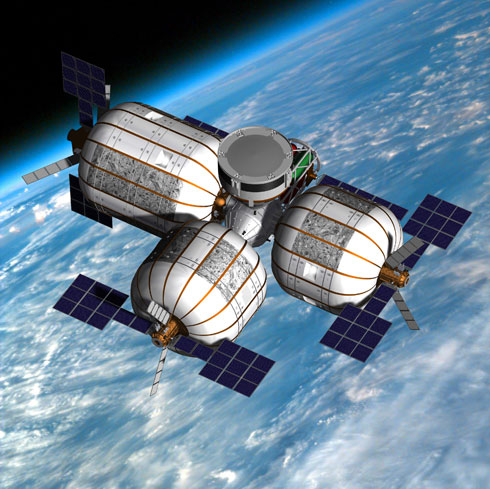The workhorse of the space program for decades — the aging US space shuttle — has a cargo bay that measures 15 feet by 59 feet. It can launch the equivalent of six large SUVs 1,000 miles up into lower Earth orbit. That might sound like a lot space, but when NASA is trying to launch a new module for the International Space Station (ISS), that cargo space is a critically limiting factor.
Which is why NASA has in the past few months been talking to Las-Vegas-based Bigelow Aerospace about producing a new module for the International Space Station based on a simple, space-saving concept: the balloon. When stowed in the space shuttle’s cargo bay, the module would be deflated to save space. But once unloaded in orbit, the module would inflate like a very tall doughnut, providing a large ring of usable space for any number of tasks. The center of the doughnut would contain the structure and equipment to maintain the inflated module.
The benefits to such a novel design would be immense. The primary research module for the US experiments on board the international space station has a pressurized volume of 106 cubic meters. Bigelow has plans to launch in 2014 a full-sized module with an area of 140 cubic meters. Another module Bigelow envisions will be 330 cubic meters.
All that extra space can be used for more science experiments, more storage, and more living space. Since scientists first started to plan for humans remaining in space for long periods of time, they have tried to work out how to keep them sane in such cramped quarters. Having expandable, large spaces in which astronauts could move around would help.
Former astronaut and Bigelow Aerospace employee Bill Oefelein — who has visited the ISS — told CBS Las Vegas affliate, KLAS-TV recently, “It’s nice to have privacy. On the shuttle, we had communal living all on the middeck. Sometimes I’d spend a night on the space station just to get away. [This inflatable module] is the chance to get away when they want to.”
Bigelow Aerospace had no comment for this article.
Founded ten years ago with $500 million from the fortune of its founder, hotelier Robert Bigelow, Bigelow Aerospace has already sent up two prototype inflatable spacecraft. Genesis I and II were launched in 2006 and 2007. Both are small compared to the ISS with only 11 cubic meters of usable space. Both are still operational.
NASA engineers have been experimenting with inflatable satellites for decades. The U.S.’s first communications satellite, Echo I, was a 100 foot diameter inflated ball made of Mylar launched in 1960. Despite its large volume, the entire satellite weighted less than four hundred pounds and fit into a beach-ball-sized canister during launch. Echo I passively reflected telephone, radio, and television signals. An even larger inflatable satellite, Echo II, was later launched in 1964.
In 1997, scientists at Johnson Space Center in Houston came up with the idea of using an inflatable craft for use as a living module for the new ISS or for future missions to Mars. The scientists called the concept “TransHab.”
A 45-page document laidss out the details of the TransHab concept. The 27-foot-diameter module would have three floors. The top level would have housed exercise equipment, cleaning station, and storage. Astronaut crew members would sleep on the level below, where each crew member would “have personal stowage, a personal workstation, sleep restraint, and integrated air, light, data, and power.” The lowest level would have housed the galley and a large, open space “created in response to the psychological” needs of the crew. Open space “is very important for crew morale and productivity during long duration isolation and confinement in space.”
But the ISS had been under design since since 1993 and was already being constructed when the TransHab concept was put forward. In 2000, Congress expressly scrapped the project, fearing it would only add costs and increase construction delays. NASA sold the the Transhab project to a Bigelow Aerospace.
Bigelow Aerospace has even bigger goals than becoming a part of the International Space Station. It recently signed a Memorandum of Understanding with the United Arab Emirates “to establish a next-generation commercial human spaceflight programme for Dubai and the UAE,” according to an Emirates Institution for Advanced Science and Technology press release.
Besides the UAE, Bigelow Aerospace has tentative agreements with six other national space agencies to use inflatable modules. KLAS-TV reported that the going price for a yearly lease on an inflatable station would be “a few hundred million dollars. But would still be a bargain compared to starting a complete space program,” the segment said.
With a price like that, at least tomorrow’s international astronauts will have the space to spread their feet once they’re in space.
Watch the first part of the KLAS-TV interview with Bill Oefelein below:
The second part the interview is here.









